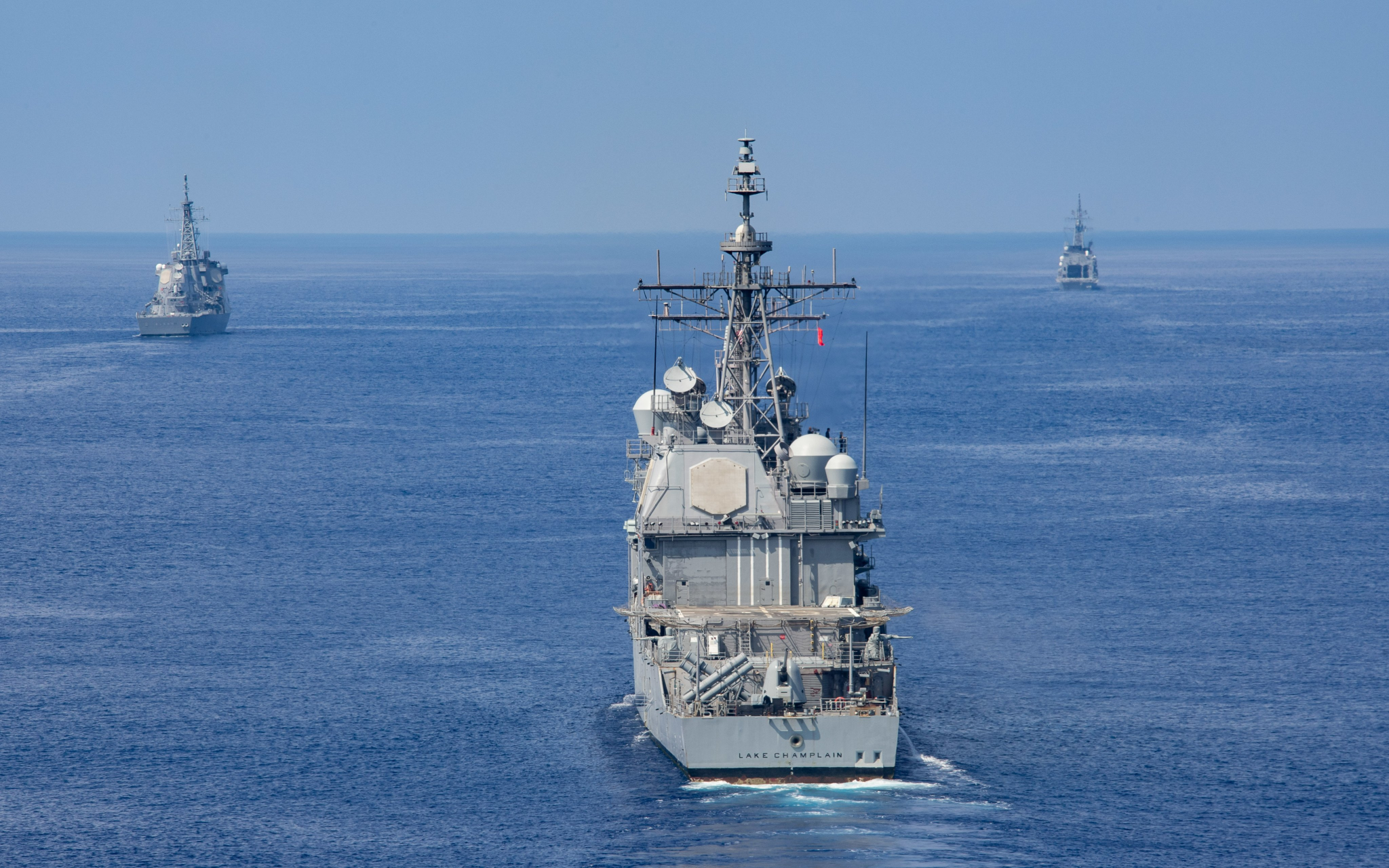Water Wars: ‘AUKUS Is Born’
Biden announces “AUKUS is born,” marking the United States’ continued shift toward the Indo-Pacific, while China implements a new maritime identification law to regulate foreign vessels within its territorial waters.

Published by The Lawfare Institute
in Cooperation With

AUKUS: Biden’s New Security Agreement
On Sept. 15, the United States, the United Kingdom and Australia announced a new security agreement. The partnership, introduced by the acronym AUKUS, expands the three countries’ already-close alliance by helping Australia develop at least eight nuclear-propelled submarines. The U.S. has previously shared the technology only with the United Kingdom.
The agreement is an example of balance-of-power politics, according to Harvard professor Stephen Walt, in which nations seek to counter the power and potential threat of one nation by empowering other nations with the capacity to check them. While China was not mentioned in President Biden’s announcement of the agreement, Walt believes AUKUS is a response to “growing perceptions of a rising Chinese threat” provoked by the country’s increased military capacity and revisionist aims in the South China Sea.
The agreement comes as relations between China and Australia have deteriorated recently. In 2018, Australian Prime Minister Scott Morrison claimed that his country does not need to choose between the United States, Australia’s close defense partner, and China, its largest trading partner. The new defense agreement demonstrates a shift in Morrison’s calculus by further integrating Australian and U.S. military capabilities. The agreement permits the U.S. to transfer highly sensitive technology to Australia to develop at least eight submarines and will allow for complete interoperability between Australia’s nuclear-powered submarines and the U.S. Pacific Fleet. “It does represent really quite sharp concerns now in the Morrison government about a deteriorating security environment in the region, about China’s military buildup and about China’s willingness to use coercive power to pursue national interests,” says Richard Maude, senior fellow at the Asia Society Policy Institute.
“A nuclear submarine has enormous defence capabilities and therefore ramifications for the region. Only six countries in the world have nuclear submarines. They are a really powerful deterrent capability without giving them nuclear weapons,” said Michael Shoebridge, director of defense, strategy and national security at the Australian Strategic Policy Institute, in an interview with the BBC.
However, certain Australian commentators have voiced concern over the new security agreement. In an op-ed for the New York Times, Sam Roggeveen, director of the International Security Program at the Lowy Institute, warned that the agreement has pushed Australia into the center of the U.S.’s rivalry with China. “Australia seems to be assuming that America will remain engaged in Asia for the long haul and will be prepared to face down China if necessary—but it shouldn’t.” James Reilly, University of Sydney associate professor of Northeast Asian politics, also fears that the deal could lead to a security dilemma between China and Australia, where both sides increase their defensive measures in response to the other side’s actions. “We end up with spirals of increasing army, military build-ups, mistrust and increasing risk of war.”
Chinese government officials and state-owned media outlets echoed similar concerns after the deal was announced. The Global Times stated that “AUKUS is obviously oriented under a Cold War mind-set” and that “it is likely to bring about a regional arms race and even nuclear arms race.” China’s Washington embassy reacted in a similar fashion. Embassy spokesman Liu Pengyu said Australia, the United Kingdom, and the U.S. “should shake off their Cold-War mentality and ideological prejudice.” Liu further drew attention to the implications of AUKUS on countries within the South China Sea by stating that AUKUS members “should not build exclusionary blocs targeting or harming the interests of third parties.”
The new security agreement may reorient power dynamics between members of the Association of Southeast Asian Nations (ASEAN), an economic and security union of 10 of the region’s states. Two ASEAN members, Indonesia and Malaysia, have also warned that AUKUS may lead to a regional arms race. In a five-point statement, Indonesia’s Ministry of Foreign Affairs claimed to be “deeply concerned over the continuing arms race and power projection in the region.” In contrast, Manila has openly supported the agreement. Philippine Secretary of Foreign Affairs Teodoro Locsin said that “the enhancement of a near-abroad ally’s ability to project power should restore and keep the balance rather than destabilize it.”
The agreement may also alienate the United States from key European allies. Upon entering into AUKUS, Australia canceled a $66 billion deal struck in 2016 to buy submarines from France. French diplomats reacted to the announcement with outrage. Jean-Yves Le Drian, France’s foreign minister, called the deal a “unilateral, brutal, unpredictable decision” by the United States, comparing the move to the sudden policy shifts made by the Trump administration. France subsequently canceled a gala at its embassy in Washington to commemorate the 240th anniversary of a Revolutionary War battle. The New York Times reported that France’s reaction is reminiscent of the country’s response to the U.S. invasion of Iraq in 2003. On Sept. 22, Biden held a 30-minute call with French President Emmanuel Macron, in which Biden “appeared to acknowledge missteps in how the United States approached the talks,” reported CNN.
The Quad Keeps Meeting
Even as Europe seethes over the Australian submarine deal, the Biden administration continued its focus on the Asia Pacific by hosting its first in-person meeting of the Quadrilateral Security Dialogue national leaders at the White House on Sept. 24. Analysts have described the “Quad”—the informal strategic consultation group between the United States, Australia, India and Japan—as having “various policy objectives, with the silent intention to counter China most often cited as a leitmotif.” According to the joint statement put out after the meeting, Biden, Morrison, Indian Prime Minister Narendra Modi and Japanese Prime Minister Yoshihide Suga discussed a range of issues, including the coronavirus pandemic and vaccine distribution, climate change, technology, supply chain and infrastructure cooperation, cybersecurity, and denuclearization of North Korea.
Significantly, the leaders noted their intention to “recommit to promoting the free, open, rules-based order, rooted in international law and undaunted by coercion, to bolster security and prosperity in the Indo-Pacific and beyond. We stand for the rule of law, freedom of navigation and overflight, peaceful resolution of disputes, democratic values, and territorial integrity of states.” Moreover, the leaders specifically promised “to champion adherence to international law, particularly as reflected in the UN Convention on the Law of the Sea (UNCLOS), to meet challenges to the maritime rules-based order, including in the East and South China Seas.” As described below, and in other Water Wars columns, China has often acted in contravention of UNCLOS and continues to claim nearly the entire South China Sea as its territorial waters. While the Quad’s statements are clearly targeted at China, the Quad has resisted becoming “an anti-China military alliance” and has instead “opted for a pragmatic and unifying focus on urgent global problems,” an approach that “acknowledges India’s reluctance to antagonize China, especially while their border dispute remains unresolved.”
New Chinese Maritime ID Law Implemented; Significant U.S. and Foreign Navy Activity in the South China Sea and Taiwan Strait
Maritime ID Law and Mischief Reef FONOP
As of Sept. 1, China now requires certain classes of vessels to provide detailed information to Chinese authorities upon entering waters that China considers to be territorial waters. These requirements, according to the Chinese maritime safety authorities, apply to “1. submersibles; 2. nuclear vessels; 3. ships carrying radioactive materials; 4. ships carrying bulk oil, chemicals, liquefied gas and other toxic and harmful substances; [and] 5. other vessels that may endanger the maritime traffic safety of the [People’s Republic of] China.” And because China claims nearly the entirety of the South China Sea as its territorial waters—in contravention of UNCLOS and the 2016 arbitral tribunal ruling—these requirements pose a significant challenge to the United States and China’s neighbors in the region. This new law is the second such Chinese attempt at asserting logistical control over the South China Sea in recent months. It follows the January passage of a law empowering the Chinese Coast Guard “to use lethal force on foreign ships operating in China’s waters, including the disputed waters claimed by China.” At the time, the U.S. State Department warned that the law could escalate maritime disputes.
In response to the new identification law, on Sept. 8, the U.S. conducted a freedom of navigation operation (FONOP) in the vicinity of Mischief Reef (Chinese: Meiji Jiao; Tagalog: Panganiban; Vietnamese: Đá Vành Khăn), a low-tide elevation within the Philippines’ exclusive economic zone (EEZ) in the hotly disputed Spratly Islands (Malay: Kepulauan Spratly; Mandarin: Nansha Qundao; Philippines: Kapuluan ng Kalayaan; Vietnamese: Quần đảo Trường Sa). The USS Benfold (DDG 52), an Arleigh Burke-class guided missile destroyer, sailed within 12 nautical miles of the reef, directly challenging both China’s territorial waters claim and the application of the new identification law. In a statement, the U.S. Navy noted that Mischief Reef is “not entitled to a territorial sea under international law.” The U.S. Navy’s characterization is consistent with the 2016 arbitration ruling, which held that “China’s claims to historic rights, or other sovereign rights or jurisdiction, with respect to the maritime areas of the South China Sea encompassed by the relevant part of the ‘nine-dash line’ are contrary to [UNCLOS] and without lawful effect to the extent that they exceed [UNCLOS limits].” The Chinese Southern Theater Command, meanwhile, condemned the U.S. destroyer as having “illegally broke into the waters adjacent to the Mischief Reef of Nansha islands without the approval of the Chinese government,” and claimed that the Chinese People’s Liberation Army (PLA) Air Force “carried out follow-up surveillance and issued a warning to drive it away.” In addition to this FONOP, the U.S Navy’s Carl Vinson Carrier Strike Group was operating in the South China Sea at the same time. The Chinese government also denied port access to the German Navy frigate Bayern, conducting a months-long patrol through the South China Sea, saying that it hoped outside countries would play “constructive” roles in the region.
Taiwan Still a Focus
September also saw more activity in the Taiwan Strait. On Sept. 26, HMS Richmond, a Type 23 frigate in the Royal Navy, sailed through the Taiwan Strait. The PLA Eastern Theater Command responded in a statement decrying the U.K.’s “ill intentions” and claiming the transit “destroyed peace and stability in the area.” The Royal Navy warship’s transit came just one week after the USS Barry, an Arleigh Burke-class guided missile destroyer, transited the Taiwan Strait, continuing the U.S. Navy’s monthly transits of the waterway. The USS Barry’s passage coincided with the end of Taiwan’s five-day, annual Han Kuang exercise. The PLA Eastern Theater Command called the transit part of “frequent provocations by the U.S. [which] fully demonstrate that the U.S. is a destroyer of peace and stability in the Taiwan Strait, and a security risk creator across the Taiwan Strait.” Meanwhile, Taiwan’s Ministry of Defense described itself as “fully aware” of the destroyer’s transit.
These transits come amid continued signaling by China about its desire and potential long-term intentions to retake Taiwan. On Sept. 8-10, a week before these transits through Taiwan Strait, the Chinese PLA Navy conducted a series of drills in the South China Sea aimed at demonstrating China’s ability to conduct island-seizure amphibious operations. As one Hong Kong-based commentator noted, the exercises were intended to “send a strong and clear signal—to regain the island they once lost.”
And more recently, beginning on Oct. 1, mainland China began sending record numbers of military aircraft to conduct sorties into Taiwan’s air defense identification zone (ADIZ), with the flights starting as mainland China celebrated its National Day holiday. According to Taiwan’s Ministry of Defense, the 145-plus aircraft still violating Taiwan’s ADIZ began their incursion on Friday when a new daily record of 38 aircraft—including H-6 bombers and J-16 fighter jets—flew into the ADIZ and headed parallel to Taiwan’s eastern coast. Then, on Saturday, an additional 39 aircraft, including anti-submarine aircraft and an early-warning-and-control plane, again violated Taiwan’s ADIZ. Sunday saw an additional 16 mainland Chinese planes enter the ADIZ, and the flights continued with another 52 on Monday.
China analyst Adam Ni says that “[c]oming on Oct. 1, China’s National Day, it sends a message about Beijing’s determination to claim Taiwan, by force if necessary. The aim of this is to assert Beijing’s power and show military muscle.” Chieh Chung, a researcher at the Taipei-based Association of Strategic Foresight, highlighted that “the PLA’s deployment of 10 J-16 fighter jets and two H-6 bombers for night missions” demonstrates China’s significant and growing capabilities. Additionally, each incursion requires a response from Taiwan’s Air Force, which has the effect of both exhausting Taiwanese resources and creating a “new normal” of Chinese incursions into the area. The U.S. State Department issued a statement expressing concern about “the People’s Republic of China’s provocative military activity near Taiwan, which is destabilizing, risks miscalculations, and undermines regional peace and stability.”
United States Announces Military Exchange with Japan
By November, U.S. Marine F-35B Lighting II Joint Strike Fighters will operate off of one of Japan’s two 24,000-ton Izumo-class helicopter destroyers, announced Marine Corps Commandant Gen. David Berger. Under Article 9 of Japan’s constitution, the country may maintain only self-defense capabilities. U.S. naval officers have argued that the planned military exchange meets this requirement. “The challenges to defending the [JMSDF] fleet against aircraft armed with cruise missiles (or hypersonic glide weapons) underscore the need to upgrade the Izumo-class to operate the F-35B STOVL aircraft, as the average range of ship-killing missiles is in the hundreds of miles while the average range of defensive ship-launched anti-aircraft and anti-missile missiles is only about 100 miles,” wrote U.S. Pacific Command Adm. Dennis Blair and retired Capt. Christopher Rodeman. This reflects Japan’s continued push to enhance its military capacity in light of China’s growing pressure.
Indonesia Adds Patrols After Chinese Survey Ship Lingers in EEZ
On Aug. 29, the Haiyang Dizhi 10, a 3,400-ton Chinese survey ship, entered into Indonesia’s EEZ. The vessel remained within Indonesia’s territorial waters at least until Sept. 21, according to Radio Free Asia. Indonesia deployed several naval vessels to the area, despite claiming the Chinese vessel had not caused a disturbance. On Aug. 31, the Haiyang Dizhi 10 entered Indonesia’s Tuna Block, near the Noble Clyde Boudreaux rig. Chinese vessels have a history of loitering within neighboring countries’ EEZs where oil and gas exploration is underway.
Analysis
Observers note that AUKUS highlights a growing divide between the U.S. and Europe’s approach to China. Whereas the U.S. wants to take a more confrontational approach focused on strengthening military alliances in the Indo-Pacific region, the European Union wants to pursue a strategy of economic cooperation. Charles Parton, a U.K. diplomat, told NBC News that key European allies “see the Americans as being confrontational with China, and they don’t believe Europe can afford to be quite so confrontational alongside them.” The divide between the U.S. and Europe has led former Australian Prime Minister Kevin Rudd to call for increased cooperation between Western states. In an interview with Spiegel International, Rudd said that “a cold war with China is probable and not just possible.” To address the significant security threat posed by China, Rudd believes Western allies must develop a common military, diplomatic and economic strategy.
In Foreign Affairs, Rudd also argues that the Quad “is uniquely problematic for China’s strategy because its aim of unifying a multilateral coalition of resistance has the potential to stiffen spines across the whole of the Indo-Pacific and possibly beyond.” Rudd describes China’s attempts to first ignore and later dismiss the Quad and explains that, in “worst-case scenario” for China, the Quad “could serve as the foundation of a broader global anti-Chinese coalition.” Rudd predicts that as the Quad continues to strengthen, China will rely on ASEAN to avoid it gaining too much sway, as ASEAN “is likely to keep its distance from the Quad, as part of its general neutrality on U.S.-Chinese tensions.” China, he writes, will also deepen cooperation with Russia and increase its own military spending.
At the Center for International Maritime Security, Ryan Fedasiuk has written a piece exploring China’s “growing fleet of autonomous undersea vehicles” (AUVs). Fedasiuk draws on a number of Chinese primary sources to identify China’s three largest AUV manufacturers and notes that a 2019 document “lists 159 undersea vehicle research projects under development at more than 40 Chinese universities—a significant increase over the 15 major universities that had constructed undersea vehicle research teams just four years prior.” Fedasiuk also explains that China’s “most mature application of AUVs is in marine surveying and reconnaissance,” but he demonstrates that mine warfare and countermeasures, undersea cable inspection, and seabed operations and anti-submarine warfare are all also ongoing or future applications of China’s AUV development. He also describes some of the technical and bureaucratic barriers facing China’s AUV industry.
Finally, in The Diplomat, A.B. Abrams analyzes why Australia’s strategic location makes it a particularly good U.S. ally to receive nuclear submarines. Japan and South Korea, according to Abrams, “make them far less well suited to deploying nuclear powered submarines, considering the security challenges that Washington is seeking to address by proliferating such weapons.” The type of diesel-electric submarines fielded by these nations is much more useful for the “short-range regional operations” they tend to engage in. Moreover, as Abrams argues, Australia’s geographic distance from China is an additional bonus: As U.S. bases on Guam and Wake Island, as well as South Korea and Japan, are increasingly considered highly vulnerable to a new generation of Chinese and North Korean armaments, Australia “provides relative safety as Guam once did in the Cold War years, but it is still close enough to be a valuable staging ground for offensive operations.






